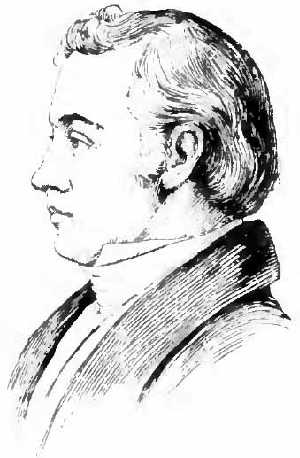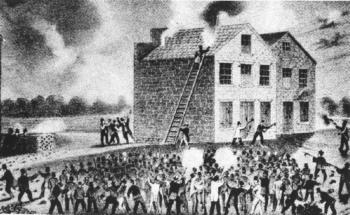 SKC Films Library |
| SKC Films Library >> Slavery in the United States |
| Elijah Parish Lovejoy abolitionist preacher/printer and martyr to his cause
Elijah Parish Lovejay was born in Albion, Maine, on November 9, 1802, the eldest son of Daniel Lovejoy, a Congregational minister, and Elizabeth Patee Lovejoy (he had six brothers and two sisters). He graduated from Waterville College (now Colby College) in 1826, taught in China, Maine for a short time, moved to Hillsboro, Illinois, in 1827, and then to St. Louis, Missouri. In St. Louis, Lovejoy originally served as the headmaster of a coeducational private school. He grew tired of teaching, however, and in 1830 acquired part ownership of the St. Louis Times, an anti-Jacksonian paper. He joined the First Presbyterian Church in 1831, and left St. Louis for the Princeton Theological Seminary the following year. Ordained in 1834, Lovejoy became pastor of the Des Peres Presbyterian Church and established the St. Louis Observer, a Presbyterian newspaper. He married Celia Ann French in 1835, and they subsequently had two children. An avid abolitionist, Lovejoy used both his pulpit and his newspaper to agitate for an end to slavery. His opinions were not well received in St. Louis, however, as Missouri was a slave state. Opposition to his position became violent in 1836, after he published a full account of the lynching of Francis McIntosh, a free African-American man who was burned to death after killing two prison guards in order to flee from jail, and the subsequent trial that acquitted the mob leaders. His press was wrecked by an angry mob, and Lovejoy decided to move both his family and his newspaper across the Mississippi River to Alton, Illinois, where slavery was illegal. Despite now being published in a free state, Lovejoy's abolitionist editorials were still read in Missouri, and Missourians began crossing the river for the sole purpose of harassing Lovejoy. The people of Alton pleaded with Lovejoy to at least moderate his position in order to avoid conflict, but he consistently refused. On July 24, 1837, Lovejoy's press was seized and thrown into the Mississippi River by an angry mob. Lovejoy's supporters helped him replace the press, but the replacement was thrown into the river on August 22nd, as was the next on September 21st. On the night of November 7, 1837, a group of 20 Lovejoy supporters joined him at the Godfrey & Gilman warehouse to guard yet another new press until it could be installed at the Observer. As the crowd grew outside, excitement and tension mounted, and the pro-slavery mob began hurling rocks at the warehouse windows. The defenders retaliated by bombarding the crowd with a supply of earthenware pots found in the warehouse. When one of the mob climbed a ladder to try to set fire to the roof of the building, Lovejoy and one of his supporters darted into the darkness to over-turn the ladder and put out the fire before it could consume the building. Lovejoy received a blast from a double-barreled shotgun, and died in the arms of his friend Thaddeus Hurlbut. Another man tried to calm the mob and was shot in the ankle. Defenders of the press then laid down their weapons and were allowed to leave. The mob rushed the building, found the press, and threw it out a window to the riverbank, broke it into pieces and dumped the broken parts into the river. The body of Lovejoy was left undisturbed until morning, guarded by friends who finally carried him home. He was buried on his 35th birthday, November 9, 1837, in an unmarked grave in the Alton City Cemetery. A monument to him was finally erected in the cemetery in 1897. SOURCES |
| SKC Films Library
>> Slavery in
the United States This page was last updated on June 10, 2018. |

